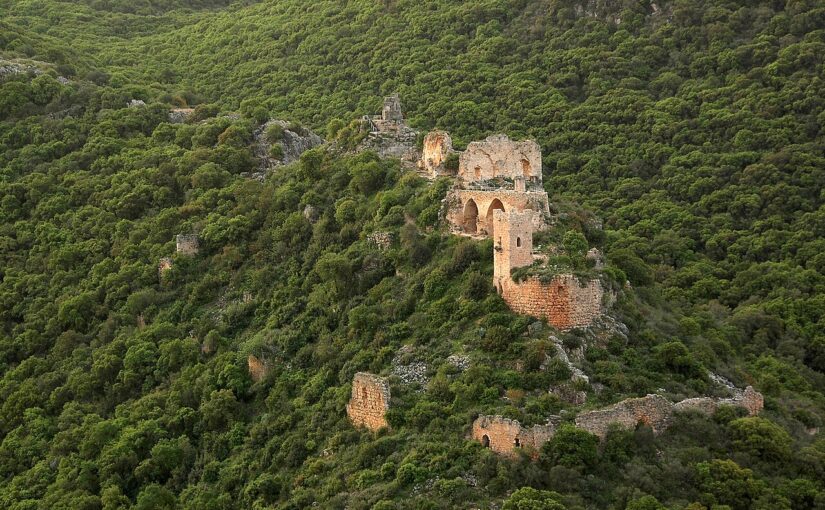Montfort Castle rises from the Western Galilee like a dream from the mist. The castle sits perched on a steep ridge above the lush Nahal Kziv stream, surrounded by ancient oaks, olive groves, and the rolling green hills of Israel’s north. It feels remote and peaceful, far removed from the bustle of coastal cities and highways. Sunlight filters through the forest canopy, glimmering on the stone ruins. In spring, wildflowers cloak the hills in color. In autumn, hikers wander beneath golden leaves. Every season lends another shade to the valley, making Montfort a true gem for travelers who crave both history and nature.
Crusader Roots and the Teutonic Order
Montfort was not always a fortress. In the early twelfth century, it began as a rural estate belonging to French nobility. The turning point came when the Teutonic Knights, a German military order forged during the Crusades, purchased the land in 1220. They sought a headquarters set apart from competing orders in Acre, and Montfort’s defensible ridge made it an ideal choice.
With the acquisition, the estate rapidly transformed into a spur-type castle. The Knights named it “Starkenberg,” meaning “Strong Mountain.” They brought in archives, treasure, and the machinery of medieval administration, seeking security for their burgeoning community. Its chief architectural features included massive defensive walls cut through the ridge, powerful towers, and elongated residential halls stacked along the narrow summit. These choices allowed the castle to control local trade routes while also offering the order a private retreat for strategic planning.
Siege, Decline, and Romantic Ruin
Montfort thrived for a brief, brilliant period. Between its completion and 1271, the Teutonic Knights made the fortress their Middle Eastern capital. Key figures guided its destiny: the Grand Masters of the Teutonic Order commanded archives and strategy from its halls, while local leadership managed defense against Mamluk incursions and internal Crusader politics.
However, this era ended abruptly. The castle faced multiple sieges from Muslim forces seeking to uproot Crusader enclaves. In 1271, Baibars led a successful assault, forcing the defenders to abandon the site for Acre. After its capture, Montfort was deliberately dismantled to prevent a return of Crusader power. The Teutonic Knights eventually departed for Europe, where they would establish new strongholds, but none with the same dramatic landscape or storied Middle Eastern foundation.
Military and Cultural Roles
More than just a defensive outpost, Montfort served as the administrative and financial heart of the Teutonic Order in the Holy Land. The castle’s vaults once guarded the order’s treasure and legal documents. Its ceremonial halls hosted councils and diplomatic receptions. The unique ridge-top design reflected its priorities: security from external threats, autonomy from rival orders, and a strategic vantage over the Nahal Kziv valley’s resources.
Culturally, Montfort grew into a symbol of the Teutonic Knights’ ambitions and challenges. It stood as both a fortification and a monastic estate, blending the roles of soldier, steward, and monk. Its ruins today attract archaeologists and travelers interested in the interplay between commerce, faith, and military engineering.
Journey into the Ruins
Today, visiting Montfort Castle is no ordinary museum walk. Travelers first glimpse the ruins from a winding path high above the valley. The approach is part of the adventure, an energetic hike through Galilee forests, alive with birdsong and the rush of Nahal Kziv’s waters. As you climb, the vistas grow more dramatic, culminating in the remains of ramparts and towers. Stone vaults, archways, and collapsed halls invite exploration, and the sense of discovery lingers with every step.
Unlike city-bound castles, Montfort’s isolation preserves an intimate bond with nature. Hikers and families picnic amid wild greenery, pausing at vantage points overlooking the Galilean hills. It is an experience both physical and reflective, offering opportunities to imagine the medieval world within these silent walls.
The Lasting Legacy
Montfort Castle continues to inspire long after its defenders departed. Its architectural innovations, including the distinctive spur-castle layout, would echo in later designs across Europe. Historians and archaeologists praise it as one of the finest examples of Crusader-era construction in the Levant. For the Teutonic Knights, Montfort remains a centerpiece of their early history, a reminder of their attempts to shape the destiny of the Holy Land with faith, discipline, and stone.
But travelers today prize Montfort for more than its historical significance. Its combination of wild beauty, profound silence, and evocative ruins offers a retreat from modern life. The castle is a destination for hikers, families, and anyone longing to step into another age. Whether following the winding paths of Nahal Kziv or contemplating the sunset from the ruined tower, each moment promises a memory shaped by nature and history.
Montfort Castle is much more than stones and stories. It is a living landmark. Here, the Galilee landscape and medieval legacy entwine, offering visitors a glimpse into the heart of an ancient world holding fast above a timeless valley.
Header image by Eran Feldman.
If our work has inspired you, helped you grow, or simply brought a little warmth to your day, consider supporting Thalysia.com with a small donation. Your contribution helps us continue exploring ancient landscapes, documenting local traditions, and celebrating the art of living well.
